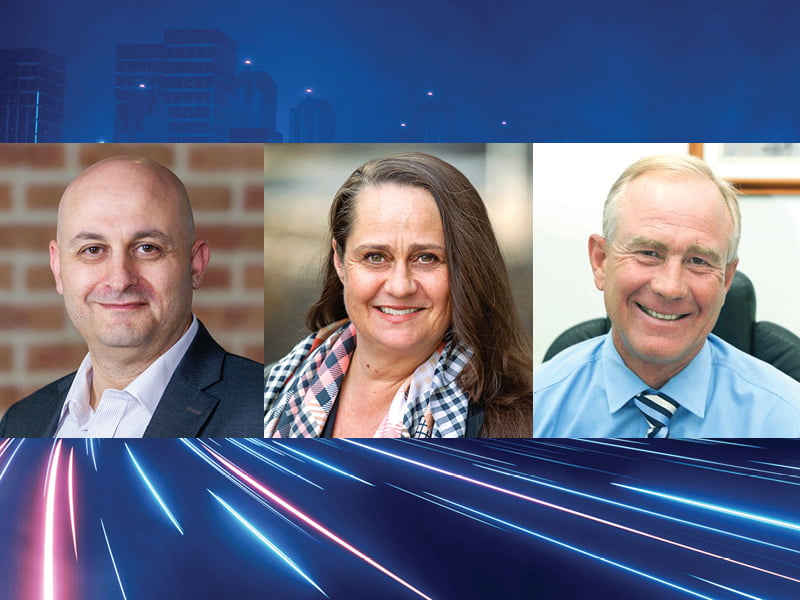Up until recently when people talked about ‘digital twins’ and spatial services, it has been in reference to architectural drawings, building layouts and the construction industry. But this is only a small and diminishing part of the story.
The reality is that digital twins and the spatial services that come with them have become integral to understanding myriad complex, data intensive environments. They have become powerful tools for managing risk and reducing cost.
Digital twins are used in everything from biotech research to retail behaviour and government service delivery – anything can benefit from large-scale data modelling.

It is no wonder then that digital twins is proliferating rapidly into all industries. The market over the next few years is expected to grow from US$3.5 billion in 2019 to $US56 billion by 2027.
Digital twins can either be a static replica such as a model of a city built from information about the location of roads, buildings and infrastructure like water, sewerage and power, or it can model an environment in real time by combining, for example, data about a piece of machinery with information from sensors monitoring its operation.
It is interesting to note that the NSW government’s spatial services agency sits within the Department of Customer Service, because it is so central to planning, innovation and the delivery of services.
In 2020 the NSW government launched what it claimed to be one of the world’s largest digital twins, which incorporated the entire state’s built and natural environment.
At its launch, NSW Minister for Customer Service, Victor Dominello, said it would represent 22 million trees with height and canopy attributes, 3D data of almost 20,000km of roads, 7,000 strata plans and 546,206 buildings. This is a very impressive static digital twin.
All of this data that is driving digital twin take-up is set to explode through the proliferation of 5G technology.
NSW Customer Service department’s Spatial Services director Wayne Patterson told the Age of Trust podcast that 5G would play an important role in transforming the state’s digital twin from a static representation of the State’s environment into a real-time digital twin.
“Enabling people to interact with the model – where they are being witnesses – is a really powerful capability for people to consume,” he said.
“I don’t think we can underestimate the demand from citizens for the ability to interact with a digital replica of their real world.”
In addition to enabling the maintenance of a real-time digital twin, 5G also plays a key role in enabling critical real-time access to digital twins, Mr Patterson said. The NSW spatial digital twin holds information on the location of critical infrastructure, such as mobile phone network towers. Destruction of these in the Black Summer bushfires seriously disrupted communications.
“Having that information in a spatial digital twin ecosystem is empowering – it really does aid decision making,” he said. “Being able to ensure first responders are able to access that information – particularly on mobile devices – is of paramount importance in order to ensure asset protection and continuity of service provision.”
Reliability is equally important. The previous wireless technology had at best three nines performance. We’ve gone from that to five nines of reliability with 5G. “That’s really important when first responders in an emergency are relying on the service,” said Verizon’s Head of Solution Architects, Tony Harb.
He said one of the biggest factors driving the rapid growth in the digital twin market is 5G – playing a crucial role in enabling the creation of digital twins that need to exchange information in real time with their real-world counterparts.
“Industries that haven’t traditionally had digital twins are starting to incorporate them,” Mr Harb added. “The retail industry is increasingly looking at modelling customer activity and behaviour in stores in real time to improve purchasing.”
In the construction industry, two of the biggest concerns are safety and managing the supply chain. “They are leveraging digital twins with 5G to get real-time data from sensors on the site, from transport and logistics and so forth so they can address safety, and any supply situation that might arise from an unexpected change,” he added.
5G had significantly greater capabilities than 4G, giving it a key role in real-time digital twins.
“We call them currencies, and there are eight of them: throughput, service deployment, mobility, connected devices, energy efficiency, data volume, latency and reliability,” said Mr Harb. “Four of those are particularly important for digital twins: throughput, the number of connected devices, latency and reliability.
“We’ve gone from a throughput that was okay to throughput of about 10 gigabits per second. At that speed you could download a high-definition movie in less than a second. Previously, it could take 30 to 40 seconds. When you want to collect data and then use that data in real time, throughput makes a big difference.”
He said Verizon can support up to one million devices per square kilometre. With previous technologies, the most it could support, with the best coverage, was about 10,000 devices per square kilometre.
“Latency is also important,” he added. “It can be less than 10 milliseconds. That’s important when you are dealing with real-time data. Anything above that is ineffective for a real-time analysis, real-time evaluation of the data you’re receiving.”
Connectivity underpins all digital twins use cases – particularly across the manufacturing and smart cities industries – and 5G is a pivotal feature of connectivity and digital transformation more broadly.
5G and digital twins could be leveraged to create value for enterprises in Industry 4.0, address the challenges of Australia’s COVID recovery to boost the economy, and support organisations in their digital transformation.
The Age of Trust podcast series was produced as a partnership between Verizon Business Group and InnovationAus.com.
Do you know more? Contact James Riley via Email.
